Letters from Lodi
An insightful and objective look at viticulture and winemaking from the Lodi
Appellation and the growers and vintners behind these crafts. Told from the
perspective of multi-award winning wine journalist, Randy Caparoso.
Two Gen Z professionals pick Lodi wines younger wine followers would love to love
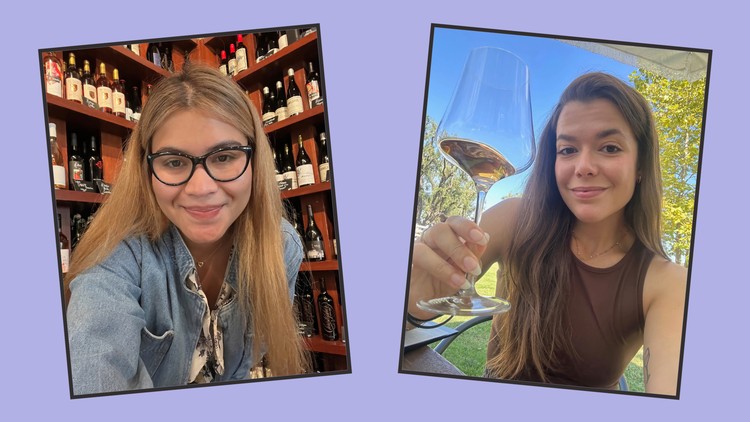
Two Gen Z Lodi wine professionals, Anna Delgado (left) and Elvira "Elvi" Fonz-Gutiérrez.
Co-written with Anna Delgado and Elvira Fonz-Gutiérrez
Just a few years ago the wine industry talk was all about Millennials (people born between 1981 and 1996). What do Millennials want? What are Millennials thinking? Especially, what are Millennials buying?
Nowadays, or so it seems, it's more about Generation Z (born 1997-2012), the latest generation to reach adult beverage drinking age. However, never in my nearly 50 years in wine-related businesses have I ever seen a generation more castigated. The general feeling in the wine industry is that early to mid-twenty-somethings just aren't interested in wine. They'd rather drink craft beer, pop cannabis products, or gulp down flavored water, of all things.
Is fine wine that uninteresting to today's youngest adults? Yes and no. Two months ago we addressed this topic in a post entitled Do not talk about what young consumers think about wine unless you're under 30. The upshot: If you want to know what Gen Z consumers think or want, you should ask them. Don't make errant assumptions. They speak well enough for themselves, thank you.

Lodi's iconic Marian's Vineyard; own-rooted Zinfandel planted in 1901.
Hence, in this post I have invited two of them who work in the Lodi wine industry⏤Anna Delgado (Lodi Winegrape Commission) and Elvira "Elvi" Fonz-Gutiérrez (Bokisch Vineyards), both 26-year-olds⏤to single out three of their favorite current wines, and explain exactly what it is about those wines that interests them.
The thinking is this: By understanding their thought process you get a tangible idea of exactly what it is that turns younger wine consumers on. You should not, of course, expect it to be exactly the same as what you find interesting.
You may also be surprised, in some cases, that early twenty-somethings like exactly the same wines as you. But for different reasons. Ms. Delgado, for instance, picked an all-time Lodi classic, a Marian's Vineyard Zinfandel by St. Amant Winery, which wows many a forty-to-sixty-something wine lover with its power and intensity of varietal character. Delgado, on the other hand, makes note of the wine's "acid-driven fruit," "soft tea-like tannins," and taste of "every component from leaf to stem from the old vineyard."
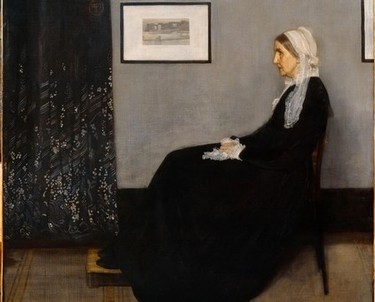
James Abbott McNeill's "Whistler's Mother."
When most old-timers taste Marian's Vineyard Zinfandel, they probably think "opulence" or "hedonistic fruit." Delgado visualizes "Whistler's Mother," an icon of American motherhood, family values, everything that is real and meaningful. You say neether, I say neither.
One of Fonz-Gutiérrez's choices is a red wine blend by Sandlands Wines, a brand that has developed a nearly cult-like following among contemporary connoisseurs. The significance, though, is that it is not a varietal bottling, made from predominantly one grape (federal law stipulates that varietal wines must be made at least 75% from a stated grape). For most of the past fifty years, varietal wines have been considered the finest wines made in the United States.
Nor is Fonz-Gutiérrez's choice one of those blends with a cute or catchy proprietary name, such as "The Prisoner," "Doohickey," "Velvet Room," "Apothic Red Espresso" or "19 Crimes Cali Red." It is simply labeled "Red Table Wine," with the Lodi appellation discreetly notated in smaller letters just above.
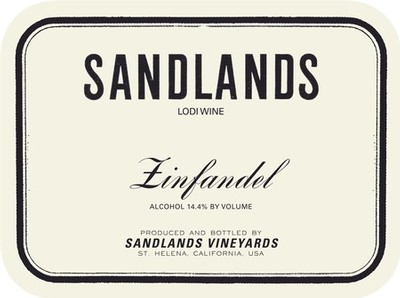
Yet, in recent years, Sandlands' blended Lodi red has probably been the most acclaimed of the approximately dozen and a half wines in this vaunted portfolio. A big reason is because of its taste, which younger consumers find particularly appealing. As Fonz-Gutiérrez puts it: "A mouthfeel that’s delicate yet has great presence, floral and spiced, capturing the uniqueness of Lodi’s soil and terroir... As the name suggests... a wine with no pretensions."
Translation: Gen Z wine lovers are more impressed by delicacy than by power, earthiness rather than fruitiness, "real" as opposed to cute or catchy. Ignore this at your peril.
But I won't put any more words in Delgado's and Fonz-Gutiérrez's mouths. Their personal recommendations, in their own words:
Anna Delgado's three wines for twenty-somethings
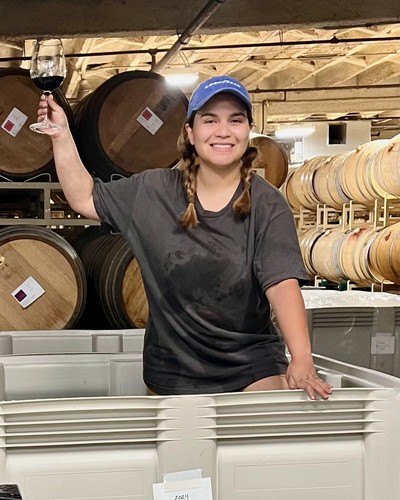
Anna Delgado in a macrobin, foot trending 2024 vintage Lodi Barbera.
2022 St. Amant Winery, Marian’s Vineyard Reserve, Lodi Zinfandel ($40)
The older we get, the fonder my friends and I become of the grapes we grew up with in the Central Valley. Our heritage grape, Zinfandel, invites joy at gatherings and complexity for lone ponderers.
In Lodi, we are fortunate to have a history of old vine Zinfandel, each vineyard with its distinct flavor profile. Marian’s Vineyard Zinfandel, planted in 1901, is farmed and cared for by Mohr-Fry Ranches, where the grapes are also LODI RULES [i.e. sustainable] certified. The family’s long relationship with St. Amant has produced multiple vintages of Marian’s Vineyard Zinfandel, the latest being the 2022 Reserve Zinfandel.
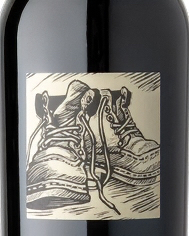
The plain yet expressive label for St. Amant Winery's Marian's Vineyard Reserve Zinfandel.
The winery's latest release, coming out in a redesigned label, was fermented with native yeast and finished with no new oak⏤a natural approach showcasing all the vineyard has to offer. Distinctly "Marian’s," the wine will open with a bright acid-driven red fruit core followed by the earthiness of whole cluster fermentation, where you taste every component from leaf to stem from the old vineyard. Coating the mouth with soft tea-like tannins, a gentle flavor of baking spice from used oak lingers in the finish, before mellowing into a brooding dark core.
Once again, [owner/winemaker] Stuart Spencer honors his family’s heritage with a wine that showcases just how beautiful Zinfandel can be. If Pinot Noir from Burgundy is like Monet’s Water Lilies, then Marian’s Vineyard Zinfandel is our Whistler's Mother.
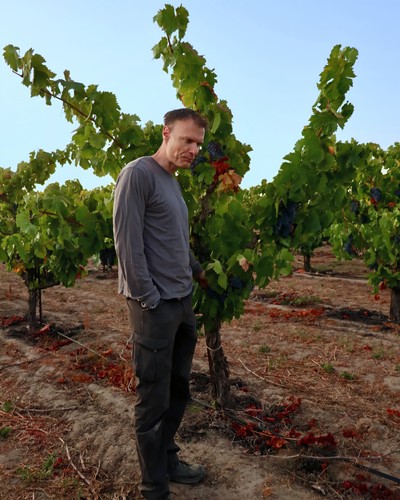
Markus Niggli during this past week's Carignan harvest.
2020 Markus Wine Co., Lodi Blue ($41)
How do you respect tradition in the heartland of California with a wine, while still expressing an individual vision? By blending grapes from historic vineyards to explore new possibilities.
Markus Wine Co.'s Swiss-born [winemaker/owner] Markus Niggli pieces his personal past with love for his new home in Lodi to create something unique to himself, while collaborating with University of the Pacific arts department on an abstract label design to add a visual layer to the expression in the bottle.
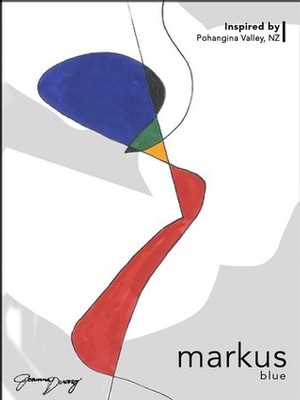
What started as an experiment to blend the 2005 plantings of Petit Verdot growing next to a landmark old vine Carignan block in Spenker Ranch turned into a Markus Wine Co. library staple. The bright blueberry-like profile and acidity of Petit Verdot [70%] carries the red currant character of Carignan [from Church Block, planted in 1938], giving the wine a classic "Markus" touch. Zinfandel [15%] adds further to the blend with earthy wet stone and forest floor aromas.
The adjustment of percentages in every new vintage of Blue is a reflection of Mr. Niggli's time getting to know each vineyard and his time spent here in the United States. It is a reflection of the heart of a true vintner. It may not be about the names of specific historic vineyards, but it is all about a love of Lodi terroir in terms of both place and people.
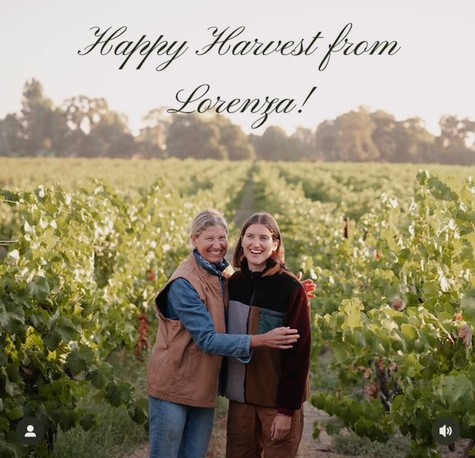
Lorenza Wine mother/daughter team Melinda Kearney and Michèle Ouellet-Benson.
2023 Lorenza Wine, Lodi Sparkling Picpoul Blanc ($40)
Your drink of choice has long been a show of your personal taste. When you order a bottle of Lorenza's Sparkling Picpoul Blanc, it is more than a glam bottle of sparkling wine. It’s about the chic community living the #LorenzaLife that you feel proud to be a part of, when you see the joyful faces of their customers celebrated on social media.
All of this is possible because the innovative mother-daughter team of Melinda Kearney and Michèle Ouellet-Benson knows what women want. A smart choice for food pairings with a unique varietal character and an elegantly made flavor profile.
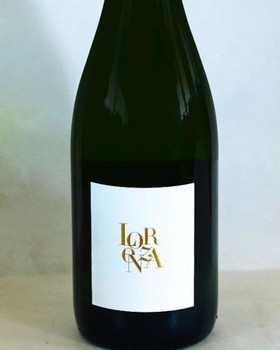
The Charmat method by which this wine is made explores every inch of flavor the Picpoul grape offers—Eureka lemon, Bosc pear, and Granny Smith apple—all juxtaposed by an "Extra Brut" level crispness followed by a deeply satisfying “ahh.”
Equally important to our current landscape is that this Picpoul is sourced from 1997/1998 Terra Alta Vineyard plantings that are both CCOF [organic] and LODI RULES [sustainable] certified. Infinitely impressive to me is Lorenza’s ability to craft a space that holds a center of respect in the world of fine wine while still making room for femininity. Indeed, it is a wine that honors a woman’s strength.
Elvira Fonz-Gutiérrez's three wines for twenty-somethings
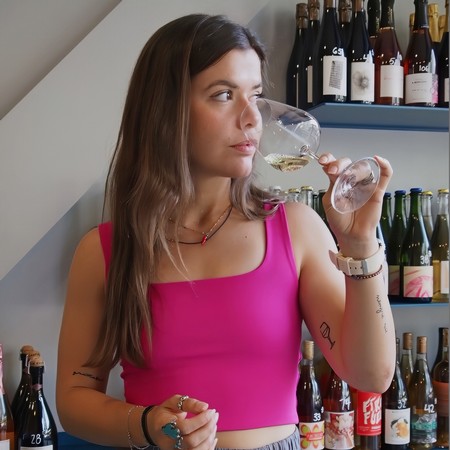
Elvira Fonz-Gutiérrez doing her thing, exploring adventurous, innovative wines.
2023 Friendly Noise, Mokelumne Glen Vineyard Lodi Bacchus ($25)
If you follow me on Instagram (@elvi.vino) or Substack (El Substack de Elvi), you already know that I found my way into the wine world after graduating as a translator and interpreter.
Even though it feels like many lives ago, that background plays a significant role in my career as a wine marketer and copywriter. In fact, both of my master’s theses in Trilingual Negotiation and International Trade revolved around the importance of language in the wine industry. Connecting with our audience starts with strong language and effective communication.
"Power of communication" is probably why I believe that the Friendly Noise brand created by winemakers Andrew and Peter has everything in its power to captivate and delight my generation in the blink of an eye: A carefully curated aesthetic and eye-catching labels, an inspiring story that speaks of pursuing their beliefs and convictions, and a master-play narrative. From the names and labels of each wine to the tasting notes and descriptions, they employ nothing tricky or complicated—just straightforward authenticity.
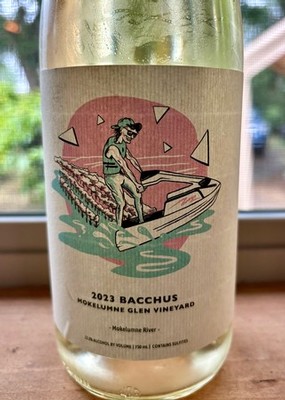
As an example, here is the description of their Friendly Noise 2023 Bacchus from Lodi: "Bacchus is the cool younger cousin Riesling always wishes it had. A cross of Riesling and Müller-Thurgau grapes, our Bacchus is full of pear and honey notes, while maintaining a crisp attitude."
This wine—and the grapes it’s made from—will always hold a special place in my heart. During my first harvest in Lodi [in 2023], the room I lived in at Ann-Marie Koth and Phil Silver’s home overlooked these very vine rows. The Bacchus, along with 51 other German varieties, is part of one of Lodi’s best-kept secrets. Winding along the Mokelumne River, these grapevines were flooded by the river's overflow during an especially harsh winter rain, just a couple months before I arrived in California.
Many winemakers decided not to purchase Mokelumne Glen Vineyards’ grapes that year because of the flooding. But this 2023 Bacchus stands as a testament to resilience, proving that hard honest work and unwavering commitment can weather any storm—or, in this case, flooding.
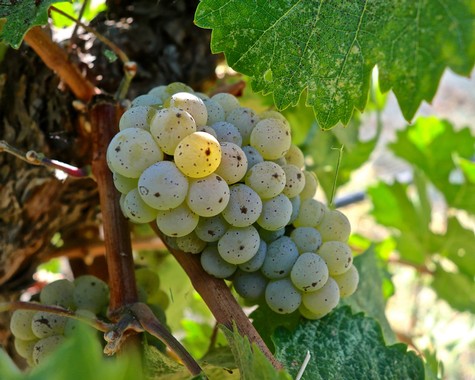
Cluster of Bacchus—a cross of (Silvaner x Riesling) and Müller-Thurgau (Riesling x Madeleine Royale)—in Lodi's Mokelumne Glen Vineyards.
We don't own a jet ski [as depicted on the Friendly Noise label], but if we did 2023 would have been a great time to do it. Conveniently, this wine would be extra refreshing after a rad day on the water!
It’s not easy to make a a relatively obscure grape variety such as Bacchus your main offering for white wine (alongside Friendly Noise's other offering, Verdejo). The good thing is that these two young beverage professionals also produce piquette and cider (and yes, these come in a canned format), getting ahead of what seems to be the market trend for the years to come. And did I mention their prices are super-affordable?
This is exactly what any member of Gen Z needs to spark a curiosity about wine. Friendly Noise is an independent, self-funded project; a dream that becomes a little more real with each harvest. If anyone ever said that the cool kids are the ones who will keep the future of the wine industry afloat, Friendly Noise is proof of that.

Sandlands owner/grower/winemaker Tegan Passalacqua.
2022 Sandlands Wine, Lodi Red Table Wine (Cinsaut, Carignan, Zinfandel; $38)
One of my most vivid memories from my earliest weeks in Lodi was attending one of the legendary Victor Book Club dinners [re Explaining the Victor Book Club]. At the time, I didn’t even know who the host [Tegan Passalacqua] was or that I was sharing the table with some of the industry's greatest professionals—some coming to the table from as far away as Italy or South Africa. We indulged in Victor Book Club's classic "meat salad" menu, paired with some of the most prestigious and iconic wines I will likely ever taste. That first night, everything was spinning around me at breakneck speed, making me feel incredibly humbled, lost amidst conversations about viticulture, terroirs, and regions that these experts knew like the back of their hands, but which were entirely new to me.
It was during a second Victor Book Club dinner that I had the chance to taste Tegan's wines more attentively. Sandlands, his personal project, is dedicated to reviving "the forgotten classic California varieties," as his website proudly states. Primarily dry-farmed and own-rooted, the vineyards he chooses to source are the result of a lifetime of study and dedication to the history and legacy of California wine. And so is the Sandlands lineup.
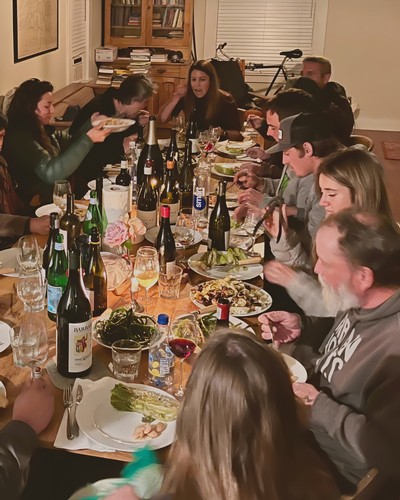
Meeting of the Victor Book Club.
If I had to choose just one wine, it would definitely be his Red Table Wine. This intentional blend combines three varieties from three of Lodi's most iconic historic vineyards: Cinsaut from the Bechthold Vineyard (planted in 1886, the oldest Cinsaut grapevines in the world), Carignan from Spenker Ranch (planted in 1900), and Zinfandel from Kirschenmann Vineyard (planted in 1915). Kirschenmann is just down the road from what was my first home in Lodi, where I used to run every week.
Blended in equal parts, these three varieties and vineyards each bring their unique character, culminating in perfect harmony—a mouthfeel that’s delicate yet has great presence, floral and spiced, and captures the uniqueness of Lodi’s soil and terroir. As the name suggests, a "table wine" in Europe is what you'd open on a regular day when you just want your wine with no pretensions, to simply make your day taste better. This wine makes the world so much better.
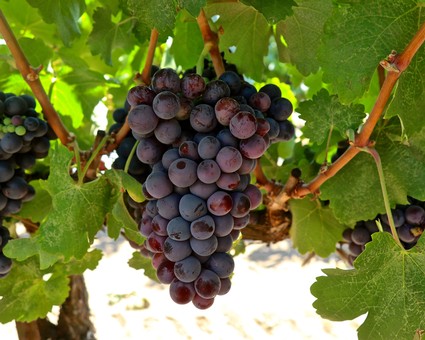
Claypool Vineyards Counoise, Mokelumne River-Lodi AVA.
2021 PRIE Winery, Claypool Vineyards Mokelumne River-Lodi Counoise ($33)
While PRIE Winery is one of Lodi's smaller neighborhood wineries, their wines could fit in the latest trendy natty wine bar in any East Coast metropolis.
After a career as a science teacher, John Gash, along with his wife Lisa, decided to purchase a traditionally farmed Cabernet Sauvignon property on Alpine Road with the intention of turning it into an ecologically balanced vineyard estate. How has this manifested itself in the wines of PRIE? The answer may surprise you.
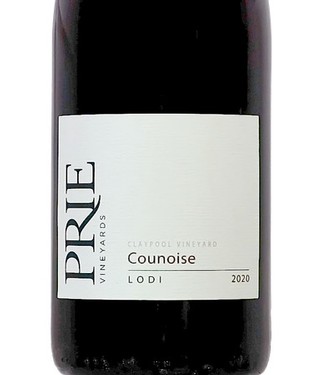
Many brands trying to appeal to my generation seem to follow a common modus operandi: High acid, low alcohol, and minimal oak influence. While PRIE's wines check all the boxes, Mr. Gash’s deep understanding of the chemical processes involved in every step of winemaking takes them a step further. With a commitment to regenerative agriculture, they use cover crops instead of till farming. They even have chickens for natural pest control! (next time you visit, try asking for an egg and wine pairing).
These farming practices, which truly listen to the land, are reflected in wines that, you could say, allow the terroir to speak—or even shout—almost as if returning the favor. Everything, from native cover crops, dry farming, and native fermentation, comes full circle and makes perfect sense in every sip.

PRIE Winery's Lisa and John Gash.
When I first discovered PRIE’s Counoise last February, I was intrigued by this unfamiliar grape, especially considering the fact that the brand’s "new wave" style focuses on lower alcohol and high acidity as markers of a more "natural" profile, which can sometimes result in underripe, hollow wines. Despite the wine's pale ruby color and low alcohol—unexpected for wines grown in Lodi's warm Mediterranean climate—PRIE’s Counoise defied my expectations, offering impressive depth and a full range of expressions. I was pleasantly surprised to find fully developed qualities with notes of plum and forest berries, coming across as round and layered.
Having evolved into a wide range of wines having a “multi-generational” appeal—from old vine Zinfandel, Barbera, and Cabernet Franc to Picpoul Blanc, Dornfelder, and even the obscure Spanish variety Prieto Picudo—the PRIE project is now the result of input from a new generation of Gashes. If these three siblings, all around my age, agree to invest their effort and future in these diverse and stylish wines, chances are the rest of our generation will happily go along for the ride!

2023 gathering of Lodi's Victor Book Club.